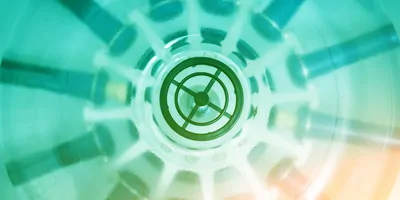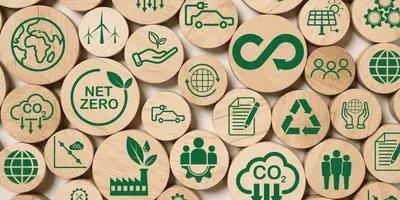In 2015, a study by the Center for Energy Efficient Laboratories1 showed that Californian laboratories use an average of 800-gigawatt hours of energy a year, generating greenhouse gas emissions equivalent to that of 122,200 passenger cars.2 It’s safe to assume this consumption rate is replicated in most other laboratories across the world. In fact, laboratories use on average five to 10 times more energy3 and four times more water than office environments.4 However, scientists are acutely aware of the issues posed by climate change and are deeply motivated to play their part in reducing the impact of their research on the environment. In turn, equipment manufacturers are helping laboratories with a range of innovations that not only focus on performance, but also tackle the pressing need to reduce environmental footprint.
By the very nature of their work, scientists are highly dependent on single-use plastics to ensure sterility in their experiments and workflow, and laboratories often require equipment that carries a heavy energy load to maintain carefully controlled temperatures. But, there are opportunities to reduce energy and make changes toward more sustainable science. Centrifuge technology is one such area of opportunity, and there have already been great strides to improve energy efficiency, increase sustainability, and reduce the waste associated with this equipment. This article explores some of the recent innovations in centrifuge technology and how these changes reduce environmental impact, while enhancing equipment performance, reducing costs, simplifying workstreams, and decreasing running times.
Sustainability does not have to mean compromise
When the United Nations introduced its Sustainable Development Goals in 2015,5 it prompted a new focus for both governments and businesses on the environment—the impact of their activities and drivers for change. Many global and regional regulatory authorities have since made bigger commitments to sustainability standards, and businesses are increasing their focus on corporate and social responsibility. Reducing greenhouse gas emissions continues to be a key target up and down supply chains—from research and development to manufacturing and distribution. For life sciences laboratories, reducing environmental impact has its challenges; consumables, for example, are still heavily dependent on single-use plastics to protect sterility, although there is an increased focus to return to reusables or innovate to make these consumables more recyclable.6 Many laboratories are increasing their focus on improving the sustainability of the equipment they use, and it is currently at the center of innovation for many equipment manufacturers.
As sustainable laboratory equipment becomes more mainstream in life sciences, the notion that sustainability comes only at the price of performance is changing. In fact, the reverse is often true. Sustainable solutions often come with many additional benefits, such as increased efficiency that often equates to reduced costs. There can be unexpected benefits too, such as fewer consumables due to more efficient equipment, and a decrease in on-site risk and waste streams owing to lower volumes of hazardous chemicals.
In relation to centrifugation equipment, manufacturers have been working closely with laboratories to understand requirements both in terms of performance and sustainability. This partnership has resulted in huge leaps in innovation in recent years.
Optimizing centrifuges for sustainability and performance
Performance sits at the heart of any innovation, and next-generation centrifuges combine advanced technology, innovative materials, and smart design to deliver high performance along with remarkable efficiency and energy savings, some by more than 70 percent.
- Greener operation—this is perhaps the simplest of the sustainability features on the market, but one of the most effective. Energy-efficient operating modes automatically detect when a centrifuge is sitting idle and put it into sleep mode. This feature dramatically decreases energy use—in some models by over 60 percent.
- Innovative rotor design—as the major moving part of the centrifuge, the rotor has the biggest energy requirement. With speeds reaching up to 30,000 rpm in some superspeed models, friction can increase energy demand. Next-generation centrifuges with wind-shielded rotors create a more efficient airflow and reduce energy requirements. Innovative rotor materials also power greater energy savings. Carbon-fiber rotors are lighter than their aluminum or titanium counterparts, providing faster acceleration and deceleration rates, and shorter run times for cost and time savings. Carbon-fiber also has a longer life than metal, since it is more resistant to damage by chemicals, which extends the in-operation period and reduces waste. Coupled with the fact that many carbon-fiber rotors are repairable, thus extending their life, sustainability benefits are further magnified.
- Minimized friction—due to centrifuge rotors spinning at such high speeds, they are especially susceptible to energy inefficiencies caused by friction. Some centrifuges now have vacuum features that remove up to 80 percent of the air surrounding the rotors, which dramatically reduces the amount of energy needed to spin samples and power the centrifuge. For maximum effectiveness, the vacuum should be adjusted according to the rotor and its speed settings, as well as to meet the requirements for superspeed programs.
- Auto-door opening with efficient cooling systems—centrifuges are carefully controlled to maintain optimal temperatures that protect samples and centrifuge technology. When doors are open and cooling systems continue to run, this energy is wasted. Some centrifuges now offer cooling system automatic shut-off features to prevent energy loss while the door is open, as well as more efficient cooling systems that further amplify sustainability and cost savings.
- Increased capacity—when the above sustainability features are combined with larger centrifuge capacity, even greater efficiencies in time, cost, and energy can be realized. Larger capacity units can run more samples in a single cycle, and fewer cycles need to be completed. In busy laboratories, where many hundreds of samples can be processed in a day, fewer cycles soon make a big difference to operating costs.
In every case, centrifuge innovation has focused on delivering greater performance. But with additional sustainability benefits, these innovations have led to improved efficiency, reduced waste, and decreased costs. Sustainability truly does benefit performance and the two can work synergistically for amplified rewards.
Sustainable centrifuges—a step on the journey to reducing carbon footprints
The next-generation centrifuges available on the market today are already having a huge impact on the industry’s carbon footprint, with some models reducing energy consumption by over 70 percent compared with traditional models. Saving 2,000-kilowatt hours over the course of a year represents a carbon dioxide equivalent of around 1.5 metric tons, and this is easily achievable through just one or two of the green features available on many next-generation models. This also translates to considerable cost savings.
Lab Management Certificate
The Lab Management certificate is more than training—it’s a professional advantage.
Gain critical skills and IACET-approved CEUs that make a measurable difference.
The sustainable centrifuges of today are certainly a taste of what is to come in the industry, as equipment manufacturers are increasingly moving to more sustainable designs wherever they can. More equipment is being designed with future repair and reuse in mind, rather than replacement. This extends to refurbishment too, where working parts of instruments that have come to the end of their life are repurposed. Such parts can then be reused in future models, ultimately reducing the need for virgin raw materials. Centrifuge manufacturers are also looking closely at their own carbon footprint. Some organizations now operate in zero-waste factories or strive to deliver new products with net-zero environmental footprints. Of course, sustainability is not new to many equipment manufacturers, and the innovative centrifuges of today are built on technology that has been introduced over several decades.
This sustainability journey continues, and through these and many other new developments, laboratories are empowered to meet their own sustainability goals, safe in the knowledge that their equipment is delivering the very best levels of sustainability, energy efficiency, and greenhouse gas reduction.
Sustainable centrifuges: a continuous pursuit of performance, efficiency, and sustainability
Thanks to changes at global and regional levels, and the commitment of businesses and individuals to do their part to reduce the impact of climate change, sustainability has become a key part of the global supply chain. This movement is growing and will become a focus for every business. As organizations shift to fully embrace sustainability as a performance indicator, collaboration with internal departments and partnerships with trusted equipment suppliers will be key. Innovation will continue to drive even greater performance, but it must also magnify its effect through sustainable deliverables.
Several centrifuges offer standalone sustainable features, but next-generation, sustainable models take this one step further, combining the very best in innovation to deliver huge energy savings, waste reduction, and decreased greenhouse gas emissions.
Environmental features are now being tied ever more closely to performance and business benefits. This means efficiencies are realized, costs are reduced, operational effectiveness is improved, and waste streams and their associated costs are minimized. Laboratories can now not only meet their sustainable objectives, but improve the services they offer at a reduced cost per sample; a win-win situation for all stakeholders.
References:
- Allison Paradise (2015) Market Assessment of Energy Efficiency Opportunities in Laboratories.
- US EPA Greenhouse Gas Equivalencies Calculator, http://www.epa.gov/cleanenergy/energy-resources/calculator.html. Accessed 03 December 2020.
- https://www.nrel.gov/docs/fy08osti/29413.pdf
- https://www.aacc.org/cln/articles/2019/march/clinical-labs-making-the-switch-to-green
- https://sdgs.un.org/goals
- https://www.labmanager.com/insights/taking-action-toward-more-sustainable-science-26468













